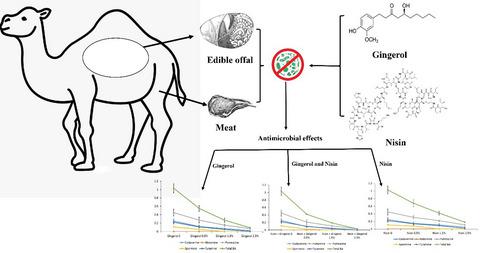当前位置:
X-MOL 学术
›
Food Sci. Nutr.
›
论文详情
Our official English website, www.x-mol.net, welcomes your
feedback! (Note: you will need to create a separate account there.)
Microbial quality and formation of biogenic amines in the meat and edible offal of Camelus dromedaries with a protection trial using gingerol and nisin.
Food Science & Nutrition ( IF 3.5 ) Pub Date : 2020-03-12 , DOI: 10.1002/fsn3.1503 Hui Tang 1 , Wageh Sobhy Darwish 2, 3 , Waleed Rizk El-Ghareeb 4 , Naser A Al-Humam 5 , Lin Chen 1 , Rui-Min Zhong 1 , Zi-Jun Xiao 1 , Jin-Kui Ma 6
Food Science & Nutrition ( IF 3.5 ) Pub Date : 2020-03-12 , DOI: 10.1002/fsn3.1503 Hui Tang 1 , Wageh Sobhy Darwish 2, 3 , Waleed Rizk El-Ghareeb 4 , Naser A Al-Humam 5 , Lin Chen 1 , Rui-Min Zhong 1 , Zi-Jun Xiao 1 , Jin-Kui Ma 6
Affiliation

|
This study aimed firstly at the investigation of the microbial status of the camel meat and edible offal including liver, kidneys, lungs, rumen, and duodenum distributed at local markets of Egypt. Total plate count, total psychrophilic counts, total Enterobacteriaceae count, the most probable number of coliforms, and total mold counts were monitored at the collected samples. The produced biogenic amines (BA) in the camel meat and offal were further estimated. An experimental trial to investigate the antimicrobial potentials of either nisin, gingerol, or an equal mixture of both using camel muscle as a food matrix was conducted. The achieved results declared a high microbial load in the camel meat and the offal. Duodenum and rumen had the highest microbial counts followed by lungs, kidneys, liver, and muscle, respectively. Similarly, duodenum and rumen had the highest levels of BA, including tyramine, spermine, putrescine, cadaverine, and histamine. Both of nisin and ginger showed significant antimicrobial properties in a concentration‐dependent manner. Thus, efficient hygienic measures during the handling of camel meat are highly recommended. In addition, using nisin, gingerol, or a mixture of both is an efficient strategy for improving the microbiological quality of the camel meat.
中文翻译:

单峰骆驼肉和可食用内脏中的微生物质量和生物胺的形成,并使用姜辣素和乳链菌肽进行保护试验。
本研究首先旨在调查埃及当地市场销售的骆驼肉和可食用内脏(包括肝脏、肾脏、肺、瘤胃和十二指肠)的微生物状况。在收集的样品中监测总平板计数、总嗜冷菌计数、总肠杆菌计数、最可能的大肠菌数和总霉菌计数。进一步估算了骆驼肉和内脏中产生的生物胺(BA)。进行了一项实验,以骆驼肌肉作为食物基质,研究乳链菌肽、姜辣素或两者的等量混合物的抗菌潜力。所取得的结果表明骆驼肉和内脏中的微生物含量很高。十二指肠和瘤胃的微生物数量最高,其次是肺、肾、肝脏和肌肉。同样,十二指肠和瘤胃的 BA 含量最高,包括酪胺、精胺、腐胺、尸胺和组胺。乳链菌肽和生姜均以浓度依赖性方式表现出显着的抗菌特性。因此,强烈建议在处理骆驼肉时采取有效的卫生措施。此外,使用乳链菌肽、姜辣素或两者的混合物是提高骆驼肉微生物质量的有效策略。
更新日期:2020-03-12
中文翻译:

单峰骆驼肉和可食用内脏中的微生物质量和生物胺的形成,并使用姜辣素和乳链菌肽进行保护试验。
本研究首先旨在调查埃及当地市场销售的骆驼肉和可食用内脏(包括肝脏、肾脏、肺、瘤胃和十二指肠)的微生物状况。在收集的样品中监测总平板计数、总嗜冷菌计数、总肠杆菌计数、最可能的大肠菌数和总霉菌计数。进一步估算了骆驼肉和内脏中产生的生物胺(BA)。进行了一项实验,以骆驼肌肉作为食物基质,研究乳链菌肽、姜辣素或两者的等量混合物的抗菌潜力。所取得的结果表明骆驼肉和内脏中的微生物含量很高。十二指肠和瘤胃的微生物数量最高,其次是肺、肾、肝脏和肌肉。同样,十二指肠和瘤胃的 BA 含量最高,包括酪胺、精胺、腐胺、尸胺和组胺。乳链菌肽和生姜均以浓度依赖性方式表现出显着的抗菌特性。因此,强烈建议在处理骆驼肉时采取有效的卫生措施。此外,使用乳链菌肽、姜辣素或两者的混合物是提高骆驼肉微生物质量的有效策略。











































 京公网安备 11010802027423号
京公网安备 11010802027423号